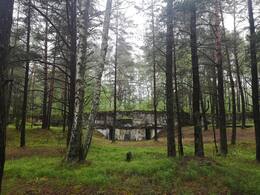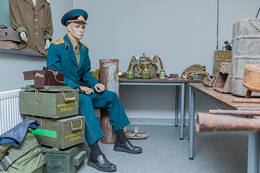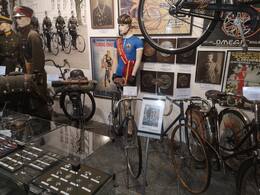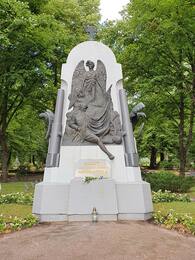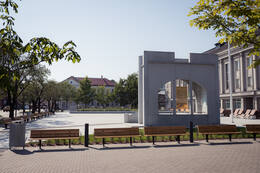The Great Cross-Border Route - Military Heritage of Latvia and Estonia over 100 Years
Day 5.
225 km
Rīga – Mangaļi – Carnikava – Pärnu
Practical info
- Driving distance: ~225 km
- In Saulkrasti, there is a beautiful view from the White Dune near the beach, and the Sunset Trail (3.5 km) along World War II tranches www.visitsaulkrasti.lv
- Visiting the Ādaži garrison exposition should be booked in advance +371 26004539.
- Individual and group guided tours in Saulkrasti Bicycle Museum by prior arrangement +371 28883160. Opening hours 10.00–18.00 daily through the summer season April 1 – August 31.
- In Carnikava, there is a promenade for walks from the town to the beach.
- Use the GPS coordinates for the Mangaļsala Fortifications to find the location. Guide services +371 29436526, +371 28664983, +371 28353679.
- Tolkuse nature hiking trail is on the way, near the ViaBaltica road www.loodusegakoos.ee
- Sights and attractions on the old road to Pärnu along the coastline rannatee.ee
Sights
Mangaļsala fortifications
Coastal fortifications are located in Riga, Mangaļsala, at the mouth of the Daugava across from Daugavgrīva. Fortifications built by different armies (Russian, Latvian, German and Soviet) can be seen here. The fortifications of Mangaļsala were built to defend the city of Riga from hostile navies. This area was strategically important for a long period of time. After World War I the Latvian Army did not yet have a strong navy. The maritime border was long and coastal defence was becoming an increasingly difficult task. The Latvian Army took over the fortifications built by the Russian Empire in the end of the 19th century and beginning of the 20th century and expanded the defence system. The artillery of Daugavgrīva and Mangaļsala would open fire on enemy ships trying to enter the mouth of Daugava, while support points at the mouth of Lielupe (Jūrmala) and mouth of Gauja (Carnikava) would stop enemy landing parties. There was also a specially equipped armoured coastal defence train that could provide artillery fire and support in the direction of Saulkrasti or Jūrmala. The aim of fortifying strategic sites was to maximise the use of weapons through special constructions and terrain advantages. Coastal defence fortifications were spread out over a large area to counter enemy efforts in the event of war.
Audio guide https://izi.travel/en/edbf-mangalsala-fortifications/en
Soviet army town in Mežgarciems
The former Soviet Army town is located in Mežgarciems, Ādaži municipality, near the P1 highway. It was a small town inhabited by the air defence units of the Soviet Army and used as a military training base. Informative stands have been placed near the town. The former army base area is available to visitors. Mežgarciems did not exist on the maps during the Soviet occupation. And there was nothing to suggest that there was a small town built for the Soviet military with air defence capabilities. Wide-spread construction of Soviet Army stations was rapidly started in the territory of Latvia after World War II. And these army bases were like separate states within the country. There were military units almost in every location in Latvia. An especially privileged part of the society was the retired USSR military personnel and their families, who were entitled to living space as a matter of priority. Many chose Latvian cities, because the standard of living here was higher than elsewhere in the Soviet Union. The presence of the Soviet Army in Latvia was characterised by criminal behaviour, imperialistic attitude and impunity, demonstrating the regime’s indifferent attitude towards Latvia and its people. And the carefully maintained myth of the happy life in Soviet Latvia and the Soviet Army as the liberator was actually like living on a powder keg.
Exposition of Ādaži garrison history
The exhibit of Ādaži garrison history is located in the territory of the National Training Centre in Ādaži, Kadaga. In this exhibit visitors can get acquainted with military equipment and learn more about the everyday life of a soldier. The largest firing ground in the Baltic States and a unique training area is located in the vicinity of Ādaži. The history of the firing ground dates back to the 20th century. At the end of the 1920s it was set up near Riga in the vicinity of Lilaste. After World War I and the Latvian War of Independence the Latvian Army was formed in a war-torn country. Latvian people had lived through war and seen the indifferent attitude of foreign armies. In a relatively short period of time the army became a large force with extensive reserves. Firing grounds and summer camps were made to resemble war conditions thus allowing the soldiers to improve their skills and knowledge. The Riga-Saulkrasti railway line, built in the early 1930s, became an important factor in the development of the Lilaste (also known as Gauja) firing ground, because it allowed easy transportation of ammunition and equipment, and it could also be used for coastal defence operations. During the Soviet occupation the firing ground was significantly expanded symbolising the military might of the Soviet Army.
Garrison – a group of military units that have been indefinitely or temporarily stationed in a certain administrative territory.
Firing ground – a place for testing equipment and training troops.
Exposition of military bikes in the Bicycle museum in Saulkrasti
The Bicycle Museum is located in Saulkrasti not far from the A1 highway and the railway station Pabaži, near the White Dune. Museum’s collection is made up of technically the most interesting examples of bicycle development history in Latvia. It is the largest bicycle collection in the Baltics with about 60 bicycles made and used in Latvia, including army-type bicycles. In the beginning of the 20th century many armies started to widely utilise the availability and benefits of bicycles. Special bicycle units were formed because of their mobility. Bicycle units were able to gather intelligence and launch unexpected attacks more easily, and were more mobile than regular infantry when it came to operations over a wide area. After World War I the Latvian Army also had bicycle units who used Latvian-made army bicycles. Any soldier who was in such a bicycle unit had to meet strict requirements. Good stamina, eyesight and hearing, as well as a healthy heart and lungs were a must. They could not weigh less than 80 kg and their height had to be 165-180 cm. The standard in the Latvian Army was that a well-trained cyclist should be able to cover 80-100 km in day, and up to 150 km in forced conditions. In winter, when bicycles could not be used, skis were used. A soldier from a bicycle unit had to be able to ski 50-60 km per day. Many soldiers from bicycle units would later become professional athletes.
We have about 5000 visitors every year.
War of Independence Monument in Pärnu
This monument was designed by Amandus Adamson. It was unveiled in Alevi cemetery in Pärnu on 16 July 1922. Its designer was buried next to it in 1929.
On 15 April 1945 the monument was blown to pieces, which were then buried. The statue of a boy with a garland was buried by local high school girls 175 metres from the monument. Luckily the graves of the soldiers were left untouched.
The garrison cemetery was renovated in 1987 and the parts of the monument (incl. statue of the boy with the garland) were dug up in 1988. On 24 February 1989 the upper part of the monument, which was found buried in its original location, was unveiled with a granite tablet reading: "1918 1920 / HERE WAS UNVEILED, ON 16 JULY 1922 THE MONUMENT TO THOSE / FALLEN IN THE WAR OF INDEPENDENCE / SCULPTOR AMANDUS ADAMSON / DESTROYED IN 1945 / 24 II 1989 P.M.S." The full restoration of the monument and cemetery was completed in stages. The monument was unveiled anew on 17 July 1993.
Monument to Proclaiming the Independence of the Republic of Estonia
This monument is situated on Independence Square in the centre of Pärnu.
Made from granite and designed by Kaarel Eelma, Mart Aas and Mikk Mutso, it was unveiled in 2008 near the former site of the Endla Theatre.
On 23 February 1918 the Manifesto to the Peoples of Estonia was publicly declared for the first time from the balcony of said theatre, which was badly damaged in World War II and later demolished.
The monument depicts the balcony of the historical theatre in its original size. It displays the text from the manifesto in both the original blackletter typeface and Antiqua, as well as in Braille.
The manifesto was published and the Republic of Estonia declared in the capital Tallinn on 24 February, transferring all authority to the Estonian Salvation Committee, later followed by the Provisional Government. 24 February 1918 is celebrated to this day as the anniversary of the Republic of Estonia.
Places to eat
Tavern “Sidrabiņi” in Jelgavkrasti
The tavern is located in the old log building close to Liepupe Church. There is an old cattle-shed next to the tavern where we make meat and sausage products that you can purchase in the Sudrabņi meat and sausage store. We offer tours and tastings.
Restaurant “Meke”, the 51st km on A1 road
Opened on June 21, 2011, at the 51st kilometre of the Tallinn-Riga highway, the MEKE KROGS pub is a typical example of the roadside pubs which used to be built along the sides of roads and near homesteads, castles, mills and windmills. This particular one is located into renovated cattle shed that is more than 100 years old – a lovely log building that is named after the former baron of the local estate, von Mecke. Alongside it is the handsome parish building which was erected in 1907 with red bricks from Tūja.
Latvian cuisine: Sorrel stew with grits, cold soup, pounded beef, mutton and vegetable stew, grits with smoked meat and mushrooms, herring with cottage cheese, bread soup.
Special foods: Porridge with bacon bits and Meke spicy sausages.
Restaurant “Pļavas” in Ainaži
Reastaurant and hotel “Plavas (“Meadows”) has become a popular destination beloved by gourmets.
Furthermore, this is definitely a place where you can enjoy a romantic dinner, and go for a night-time dip in the sea and later proceed to a room in the tasteful hotel “Plavas”.
In Salacgrīva www.visitsalacgriva.lv/en/have–a–meal
In Saulkrasti visitsaulkrasti.lv
In Carnikava tourism.carnikava.lv/en/catering
In Pärnu visitparnu.com
Places to stay
Places to stay in Pärnu visitparnu.com




